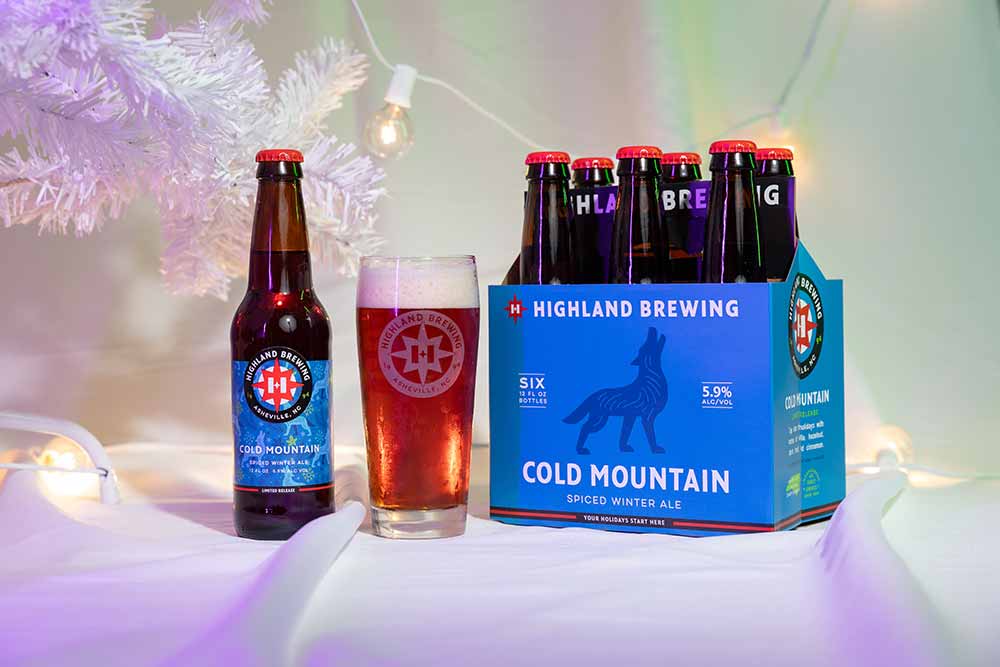
We dove deep into the fall season, highlighting the U.S. hop harvest from a grower’s and brewer’s perspective and covering how to brew the best versions of the ever-popular Oktoberfest-style beer. As the seasons shift to the colder months, the focus also moves to more comforting options. We recently wrote about the doppelbock and how much of a punch the high-ABV, malt-forward beer packs. The winter warmer also falls perfectly into that seasonal category.
To learn about the beer, the top things to consider when making one, the ideal recipe, and what ABV to shoot for, we talked to Highland Brewing Quality Manager Megan Rayfield and longtime brewing veteran Fal Allen, who spent two decades at Anderson Valley Brewing Company before recently becoming the head brewer at Napali Brewing in Hawaii.
(Above photography courtesy of Highland Brewing)
What We’ll Cover in This Piece:
Affordable, Industry-Leading Brewery Software
How the Experts Define Winter Warmer

Photography courtesy of Highland Brewing
When you hear winter warmer, there’s nothing inherently beer about the name. Allen notes that the beers were originally made in England to warm up folks on cold nights. So that’s what this beer should provide—warmth.
“[To get that], you need higher alcohol—5% ABV should be the bare minimum,” Allen says. “Most winter warmers are malt forward, and you’re looking for roundness and sweetness— something more contemplative than a regular beer.”
But the beer is somewhere along the lines of a British strong ale with a strong emphasis on malts and a red-brown hue for color.
“That’s the mother there,” says Rayfield, speaking of the British strong ale. “The base beer, I’m thinking it’s rich and malty, reddish brown color, nutty, complex fruit esters, and midrange ABV like 5.5% to 8% [ABV].”
But the path to making one is not exactly clear.
“The guidelines blur so much,” Rayfield says. “Regional differences in brewing and preferences can come into play.”
With a Winter Warmer: To Spice or Not to Spice?

Photography courtesy of Katee McGee | Anderson Valley Brewing Company
The Beer Judge Certification Program notes that a winter warmer is a stronger, darker, spiced beer that often has a rich body and warming finish, suggesting a good accompaniment for the cold winter season.
According to the Beer Judge Certification Program (BJCP) guidelines, “Winter Seasonal Beers are beers that suggest cold weather and the Christmas holiday season, and may include holiday spices, specialty sugars, and other products that are reminiscent of mulling spices or Christmas holiday desserts.”
Emphasis on “may” for the spices. Allen says that the beers could be spiced, but those flavors could also come from the yeast or during fermentation.
“I’ve spiced it and done it both ways,” Allen says. “Spices need to be even-handed and done judiciously.”
Allen adds, “You look for those seasonal ones—things you might find in holiday desserts, like cinnamon, nutmeg, the more traditional holiday Christmas spicing.”
The spice is what Rayfield feels makes the winter warmer special.
“It’s the addition of the spices that sets it apart,” she says. “Taking those traditional flavors, holiday spices, and infusing those into a winter ale is the key.”
Rayfield adds, “I think some type of adjunct or spice defines a winter warmer in its own category. I think of things like cinnamon, vanilla, something like a holiday pie.”
What to Watch for When Brewing a Winter Warmer

Photography courtesy of Kevin McGee | Anderson Valley Brewing Company
Rayfield points to being careful with the spices.
“Cinnamon is easy to go overboard,” she says. “When you get it just right, it adds a layer of warmth, [but] it is easy to go a little too hard.”
Rayfield adds, “Think carefully and start smaller—you can add things, but can’t take it away. Be mindful of how you add it.”
Rayfield says you can add the spices on the hot side during the whirlpool, steep it in the fermenter, or add them to some finished beer in the brite tank. Highland opts to add it in the brite and follows the manufacturers’ recommendations for dosage rate.
“Have fun with it and add the flavor combinations you like,” Rayfield says. “We have a winter warmer that we do as a limited seasonal release for twenty-eight years. It has four components: vanilla, cinnamon, some type of fruity component, and some type of nutty component.”
She adds, “We play around with fruit-nut profile. This year, it’s cranberry and hazelnut.”
In the nearly three decades Highland has made its winter warmer, Rayfield says they have dialed in the spice ratio. She suggests, “If you find a profile working for you, lean into it.”
Allen thinks fermentation is the key.
“Get a good strong yeast culture to get it going and go all the way through,” he says. “That’s really important.”
He adds, “You need to make sure you have a good yeast starter and the wort is well-oxygenated. And don’t leave too many residual sugars. You want to ferment warm, but not too warm. Around seventy to seventy-two degrees Fahrenheit is good. Maybe a little higher if you’re being daring.”
Outside of fermentation, Allen points to malt choice as the next most crucial element of the winter warmer.
“I like to use some colored malts, which will help with those round and dark fruit flavors like plum and cherry,” Allen says. “Some of the darker malts lend it color and roundness and build that malty character. You’ll need enough hops to balance it, but it should still be malt-forward.
What Grist Bill Makes for the Best Winter Warmer?

Photography courtesy of Elliott Harris | Anderson Valley Brewing Company
“You’ll certainly use a bit of pale malt—like eighty to eighty-five percent,” Allen says. “Then I prefer to use some dark malts like roasted malts, around two to eight percent, and use a little bit of Munich to help with the body, and a small amount of caramel malt, but not too much.”
Because crystal and caramel malts tend to oxidize, Allen doesn’t opt toward too much of those, especially because these beers, he says, should be made in the late summer and released in the mid-to-late fall when the weather cools.
“You don’t want beers to develop oxidization over aging,” he says. “So I try to minimize crystal and caramel malts.”
Allen says the mash should be like the English did it: single infusion with temperatures ranging between 150°F to 152°F.
“Because you don’t want too much sweetness,” he explains. “You’ll have that with alcohol and esters from the yeast. Mash below that temperature, and you’d dry that out a little too much.”
Rayfield says that the brew team at Highland starts with a two-row base malt and adds some caramel malt for color and sweet flavors.
“We [also] add a tiny bit of chocolate malt for depth and a small percentage of wheat to add fullness to the body,” Rayfield says. “They work hard to dial the correct strike temp to hit the final ABV.”
What Hops Should You Use and What IBU Should You Target for Winter Warmer?

Photography courtesy of Highland Brewing
Rayfield says Highland opts for Cascade and Mt. Hood hops for its winter warmer.
“They are neutral hops,” Rayfield says. “We’re not looking to add much bitterness or hop profile. [We’re] looking to add balance to the malt profile.”
She says they use Cascade for the bittering and then a combo of Cascade and Mt. Hood hops in the whirlpool.
“We target thirty IBUs,” she says.
Allen says it’s not about the varietal as much as about getting the appropriate bitterness.
“We use a high-alpha [hop] to bitter,” Allen says. “Depending on your ABV, you want something in the neighborhood of twenty-five to forty-five IBUs.”
Allen adds, “For flavor or finishing, I’d pick something English because that’s the style. Stick to the English ones and go for medium amounts—it’s not a hop-forward beer. You can put in some [in a] late addition to get some aroma, but don’t overdo it.”
Allen says they use around a quarter to a half pound per barrel for the late hop charges.
“It’s not a lot,” he says. “It’s about the malt, not about the hops.”
Where Should the ABV be for a Winter Warmer?

Photography courtesy of Josh Wray | Anderson Valley Brewing Company
The ABV should push a little higher to get that perceived warmth from the beer. Allen shoots to balance the higher ABV with optimal drinkability.
“I kind of like that 6.5% to 7% ABV range,” Allen says. “You get much over 7% ABV, and consumers won’t drink two or three; they’ll drink one.”
He adds, “So I like to make my beers midrange.”
Highland’s winter warmer goes even lower in ABV.
“Ours is 5.9% ABV,” Rayfield says. “And then we do an imperial version that comes in at 8% ABV.”
She notes that anything stronger “might be outside the winter warmer range, in my opinion.”
Two Examples of a Great Winter Warmer

Graphic courtesy of Anderson Valley Brewing Company
Allen has yet to make a winter warmer at Napali, but at Anderson Valley, he made a highly regarded take on the style called Winter Solstice. The beer is 6.9% ABV and is lightly spiced, with minimal IBUs, according to its Untappd page.
“It’s always been popular,” Allen admits. “It has a big solid roundness and a nice deep orange color. The alcohol is midrange, and… [we’ve] stuck with that recipe.”
Highland has Cold Mountain, a winter warmer with an almost cult-like following they’ve been making for nearly three decades. The beer is 5.9% ABV with twenty-eight IBUs and a “secret blend” of spices.
“It’s much bigger than just the beers in the bottle,” Rayfield says. “We’ve cultivated a huge local following behind this brand. … It’s something for folks all around the Southeast—people come from Charlotte, Atlanta, the Carolina coasts—because it’s such a special vibe, and everyone wants to get in on it.”



